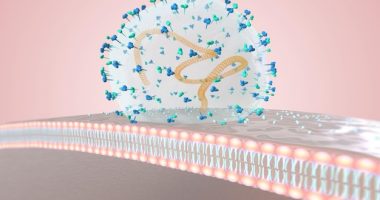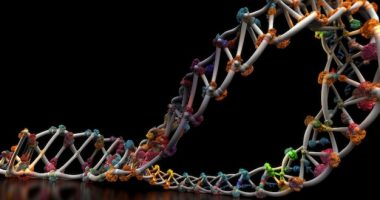In the realm of electromagnetic interference (EMI) solutions, wideband electromagnetic wave absorption nanostructures play a pivotal role, particularly in advanced communication systems where minimizing signal disruption is critical. A groundbreaking study by Xiaopeng Li and collaborators introduces an innovative approach that synthesizes wideband electromagnetic wave absorption nanostructures, focusing on the development of MoSe/CoSe@N-doped carbon (NC) composites with unique hollow core-branch nanostructures. This research addresses the pressing challenge faced by MoSe due to its relatively low electrical conductivity, which traditionally hampers its effectiveness in electromagnetic wave absorption (EMWA).
Utilizing a strategic selenization process of MoO nanorods enveloped in ZIF-67, the team skillfully manipulates the electromagnetic properties and structural morphologies of the resulting composites. This meticulous adjustment ensures improved impedance matching, significantly enhancing EMWA capabilities. The formation of a heterostructure within the composites is key, promoting efficient charge transfer, and inducing a beneficial distribution of charges that increase conductive and polarization losses—critical factors for effective EMWA. Furthermore, the hollow core-branch design enriches the structure with conductive networks and heterointerfaces, maximizing the charge transport as supported by density functional theory calculations.
This research not only pushes the boundaries of nanostructure fabrication but also opens new avenues for the design of materials that can provide enhanced EMWA over a broad spectrum of frequencies, as demonstrated by the impressive EMWA results showing a peak reflection loss of -53.53 dB. Through such innovations, the team outlines a promising path forward for addressing complex challenges in electromagnetic wave management.
### Background and Context of Wideband Electromagnetic Wave Absorption Nanostructures Research
The study of wideband electromagnetic wave absorption nanostructures has gained significant traction in recent years, driven by the escalating demand for advanced communication technologies that operate seamlessly in environments plagued by electromagnetic interference (EMI). The onset of 5G networks and beyond, coupled with an increasing number of electronic devices per capita, heightens the need for effective EMI shielding solutions to ensure reliable and uninterrupted operation. Wideband electromagnetic wave absorbers are of particular interest as they are designed to mitigate interference across a broad spectrum of frequencies, making them integral to modern electronic and communication systems.
Traditional materials used in electromagnetic wave absorption (EMWA) have faced limitations in terms of bandwidth and efficiency at high frequencies. Materials such as ferrites, although effective under certain conditions, are typically bulky and have limited effectiveness across a wide range of frequencies. This paves the way for the utilization of nanostructured materials, which can be engineered at the molecular level to achieve properties that are not possible with conventional materials.
The introduction of nanostructures like MoSe (Molybdenum Selenide) and CoSe (Cobalt Selenide) embedded in an N-doped carbon (NC) matrix represents a significant leap forward in this field. These materials, structured at the nanoscale, exhibit unique properties conducive to EMWA, such as enhanced magnetic losses, dielectric losses, and multiple scattering mechanisms. The core challenge, however, has been MoSe’s low electrical conductivity, which restricts its ability to effectively absorb electromagnetic waves.
Responding to this challenge, the pioneering work by Xiaopeng Li and colleagues leverages a novel fabrication process that enhances the electrical properties of MoSe by incorporating it within a conducive CoSe@N-doped carbon matrix. The process, a sophisticated selenization of precursor MoO nanorods within a ZIF-67 framework, results in composites with optimized electromagnetic properties and structural morphologies that cater specifically to EMWA. The introduction of a hollow core-branch architecture in these composites is especially noteworthy; it not only contributes to a reduction in material density, making the absorbers lighter and more viable for practical applications, but also enhances the surface area, facilitating multiple internal reflections and absorption pathways.
In summary, the development of wideband electromagnetic wave absorption nanostructures addresses a critical need in the field of electromagnetic compatibility. By engineering the composition and structure at the nanoscale, researchers like Xiaopeng Li are opening up new pathways to combat EMI in increasingly crowded spectral environments, ensuring clearer signals and improved functionality in a wide array of electronic devices and communication networks. This advancement not only signifies a technical achievement but also highlights the importance of material science innovation in solving real-world problems associated with technological progress.
### Methodology of Synthesizing Wideband Electromagnetic Wave Absorption Nanostructures
The research by Xiaopeng Li and his team on creating effective wideband electromagnetic wave absorption nanostructures involved a comprehensive approach that integrated advanced material synthesis, structural design, and theoretical analysis to improve the EMWA properties of MoSe/CoSe@N-doped carbon (NC) composites. The process began with the preparation of the precursor materials and was followed by a series of synthesis steps to construct the unique hollow core-branch nanostructures. Here, each step is detailed, showcasing the innovative techniques used to enhance these materials’ electromagnetic wave absorption capabilities.
#### Preparation of Precursor MoO Nanorods
The initial stage involved the synthesis of MoO nanorods, which served as the template for the subsequent processes. These nanorods were prepared using a hydrothermal method that ensures the formation of uniform and structurally aligned rod-like molybdenum oxide shapes. This shape and consistency are crucial as they dictate the final morphology of the composite structure.
#### Encapsulation in ZIF-67
Following the synthesis of MoO nanorods, the team encapsulated these rods in ZIF-67 (zeolitic imidazolate framework-67), a type of metal-organic framework known for its high surface area and porosity. This step was critical as ZIF-67 plays a pivotal role in the selenization process, ensuring that the final product retains a hollow structure, which is essential for enhancing electromagnetic wave absorption.
#### Selenization Process
The encapsulated nanorods were then subjected to a selenization process. Under specific thermal conditions, the MoO within the ZIF-67 framework reacted with selenium vapor, converting into MoSe. Concurrently, the cobalt from the ZIF-67 framework reacted to form CoSe. This step was crucial for the formation of MoSe/CoSe nanostructures within an N-doped carbon matrix, significantly enhancing their electrical conductivity and electromagnetic properties.
#### Creation of Hollow Core-Branch Structures
The unique hollow core-branch structures were finally realized through a controlled removal of certain components and further carbonization of the organic parts of ZIF-67. This phase is vital for developing the final architecture of the nanostructures, as it contributes to the lightweight and high surface area characteristics of the composites, facilitating better impedance matching and multiple internal reflection mechanisms.
#### Characterization and Electromagnetic Testing
Comprehensive characterization techniques, including SEM, TEM, XRD, and BET were employed to verify the morphology, crystalline structure, and porosity of the synthesized nanostructures. Electromagnetic properties were evaluated using vector network analyzers to measure the reflection loss across a wide range of frequencies, confirming the wideband electromagnetic wave absorption capabilities of the nanostructures.
By skillfully combining these methodologies, the research successfully addresses the inherent limitation of MoSe’s low electrical conductivity and demonstrates a significant improvement in EMWA performance, making a vital contribution to the field of wideband electromagnetic wave absorption nanostructures. Through this tailored approach, the team was able to achieve impressive EMWA results, with reflection loss measurements showcasing effective damping of electromagnetic waves, crucial for advancing modern communication technologies.
### Key Findings and Results of Research on Wideband Electromagnetic Wave Absorption Nanostructures
The research led by Xiaopeng Li on wideband electromagnetic wave absorption nanostructures culminated in several groundbreaking findings that address key challenges in the field of electromagnetic interference (EMI) management. Utilizing the novel MoSe/CoSe@N-doped carbon (NC) composites, the study demonstrated exceptional results, primarily characterized by enhanced electrical conductivity and superior EM wave absorbing performance.
#### Enhanced Electrical Conductivity and Impedance Matching
One of the key highlights of the study was the significant enhancement in electrical conductivity achieved through the strategic incorporation of CoSe and N-doped carbon in the MoSe matrix. This not only overcame the intrinsic limitations of MoSe’s low electrical conductivity but also improved the impedance matching capability of the composites. The enhanced electrical conductivity facilitated efficient charge transfer across the material, which is critical for the absorption of electromagnetic waves.
#### Superior Wideband Electromagnetic Wave Absorption
The results revealed that the MoSe/CoSe@N-doped carbon (NC) composites exhibited superior wideband electromagnetic wave absorption capabilities, across a broad spectrum of frequencies. The peak reflection loss measured in this study was an impressive -53.53 dB, indicating a highly efficient absorption of EM waves. This significant reduction in reflection underscores the potential of these nanostructures in shielding and absorption applications, particularly in environments where a wide range of frequencies need to be managed.
#### Structural Advantages
The hollow core-branch architecture of the nanostructures played a vital role in achieving these results. This unique design provided multiple internal reflection pathways, which increased the interaction of electromagnetic waves with the material, thereby enhancing the absorption effectiveness. Moreover, this structure contributed to the overall lightweight nature of the composites, making them suitable for practical applications where heavy materials are infeasible.
#### Broad Application Potential
The wideband electromagnetic wave absorption capabilities demonstrated by the MoSe/CoSe@N-doped carbon (NC) composites open up broad application possibilities beyond just EMI shielding. These include applications in stealth technology, sensor protection in harsh environments, and improving the reliability and efficiency of wireless communication systems by mitigating interference.
In summary, the research on wideband electromagnetic wave absorption nanostructures not only provided insights into improving the material properties essential for EMI management but also showcased a scalable approach to fabricating high-performance EM wave absorbers. The incorporation of MoSe with CoSe and N-doped carbon to form structured nano composites marks a significant advancement in the field, enabling the development of materials that can effectively absorb electromagnetic waves across a wide array of frequencies. These findings pave the way for new technologies and improvements in existing systems, significantly impacting various sectors reliant on advanced electronic and communication systems.
### Future Directions and Final Thoughts on Wideband Electromagnetic Wave Absorption Nanostructures
As the pioneering research by Xiaopeng Li and his colleagues pushes the boundaries of material science in the domain of electromagnetic interference management, the future of wideband electromagnetic wave absorption nanostructures looks promising. The development and optimization of MoSe/CoSe@N-doped carbon (NC) composites offer a glimpse into the myriad possibilities and applications that these materials could unlock. However, to fully harness the potential of these groundbreaking nanostructures, several future directions should be considered.
#### Enhancement of Material Properties and Scalability
Continued research into improving the material properties of nanostructures is crucial. This involves refining the synthesis processes to achieve even better impedance matching and broadband EMWA capabilities. Scalability of production processes will also be a significant factor in transitioning these materials from the laboratory to industrial applications. Addressing these aspects will help in meeting the commercial demand and maintaining the material’s performance integrity on a larger scale.
#### Integration with Existing Technologies
Integrating these advanced materials with current technologies, especially in communication and defense sectors, poses a substantial opportunity. Research should focus not only on the material itself but also on how it interacts with and enhances existing systems, such as in radar-absorbing materials in stealth technology or in enhancing the efficiency of antennas by reducing energy loss due to interference.
#### Expanded Theoretical and Experimental Studies
The theoretical frameworks, such as the density functional theory calculations used in this study, provide essential insights into the material behaviors at the atomic level. Expanding these studies to include more complex models and simulations could lead to the discovery of even more efficient material compositions and structures. Experimentally, long-term durability and environmental impact studies will be crucial to ensure the materials’ effectiveness and sustainability over time.
#### Broader Spectrum Applications
As the electromagnetic spectrum becomes increasingly crowded, materials that can offer wideband absorption will be critical. Therefore, further research could explore the capabilities of these nanostructures across different electromagnetic spectrum ranges, including ultraviolet or infrared, which could open up new applications in non-visible light technologies.
### Conclusion
The innovative strides made in the research of wideband electromagnetic wave absorption nanostructures set a robust foundation for future advancements in EMI solutions. The remarkable achievements demonstrated by the MoSe/CoSe@N-doped carbon (NC) composites underscore the immense potential of nanostructured materials in addressing complex challenges posed by the modern electronic and communication landscapes. As this field evolves, it will undoubtedly contribute significantly to the development of new technologies that ensure clearer communication channels, enhanced security measures, and more efficient electronic devices. Moving forward, the focus on optimizing these wideband electromagnetic wave absorption nanostructures will be pivotal in shaping the future of telecommunications and electronic systems worldwide.









